2009年11月13日
第七堂Biomechanics课
上新期,艺树人以一系列的活动来练习Meyerhold的otkaz, posil和stoica:
- 边走,边把网球随意丢给对方
- 大家集合成组,各组随意走动,但换方向时不是随着一个人的带领,而是整组人的舆论 (与“fish exercise”相反)
- 俩人之间的“老鹰捉小鸡”游戏
艺树人各个的动作必须干净利落,才能让对方有办法预料自己的下一个动作。
接着,我们以腹部的肌肉,以上的三个原则和 tochka的变化来锻炼自己的平衡。李邪把同样大小的木立方体摆成一线,让艺树人像踩石头过河一样地踩过它们,到房间地另一端。立方体之间的距离慢慢地增加、大小和方向也变了,加上李邪的其他要求,例如转动身子或在原地转圈才能踩在立方体上。这些小小的更改使每向活动比之前的更难,但大家都玩得很开心。
休息过后,我们继续学习李邪为艺树人设计的Meyerhold的etude, “The Slap”。艺树人学会了Meyerhold的握手方式,还有准备给人一巴掌的姿势。从头练习整个etude是一件蛮辛苦的事,因为Meyerhold要求的准确性和我们平常不习惯的姿势使用的肌肉很少会被动用到。要不是这些etude,我想,这些肌肉差不多能说是永远都不会派上用场。
艺树人也以竹竿训练自己的平衡。我们得一边以手掌心平衡竹竿,一边在房间里走动、结伴在房间的中央点相遇,也让竹竿在两手之间交换。平衡着这么长的一支竹竿到处乱走一点也不简单,但看着对方怕竹竿掉的那焦急的样子实在另人发笑。
课结束时,艺树人的肌肉大多数都有点酸痛。但是,参插了喜悦和欢笑,一切都是值得的。这星期,我们应该会学习怎么给对方一巴掌了吧。真期待星期六的课!
In our last lesson, ARTivate continued working on our otkaz, posil and stoica through games activities such as:
- Throwing an increasing number of tennis balls across the room while moving in a random manner
- Moving around the room in groups, with every change in direction effected by general consensus and not following a leader (as opposed to the “fish exercise”)
- The game of laoyingzhuoxiaoji (“eagle and the chicken/chick”?) between each pair
Each ARTivator had to ensure that his/her actions are executed precisely so as to facilitate anticipation in the other parties.
We then practised our balancing skills, which consists of grouping our core muscles, the three principles listed above and switching of our tochka every step we take. Wooden cubes of the same size were placed in the middle of the room and every ARTivator had to cross the room by stepping on them, similar to crossing a river while stepping on stones. The distance between each cube was slowly increased and soon, even the size of the cubes was varied, and also the orientation of the cubes. Other requirements were added, such as rotating your upper body three times before crossing the “river” and spinning 360° before getting up a cube. All these little changes increased the difficulty at each stage but they were really simple activities that could keep us entertained.
We then continued learning Meyerhold’s etude, “The Slap”, as modified by Li Xie for the amateur ARTivators. From last week’s “greeting position”, we proceeded on to “greet” and “preparation to slap”. Revising these actions right from the start was really tiring. All the weird angles and the need for clean lines definitely put my lazy muscles to a good test.
We concluded the day by honing our balance with the help of bamboo poles. By balancing these poles on our palms, each ARTivators had to move around the room, meet up with a partner halfway through and even shift the poles from one palm to another. It certainly was no easy task moving around with a long extension from the middle of your palms but nonetheless, we enjoyed that activity very much.
Once again, the lesson ended on quite a good note, with it’s fair share of laughter and muscle aches (from staying in the same position while practising the etude). I’m definitely looking forward to learning the actual slap. *evil laughter*

关于艺树人
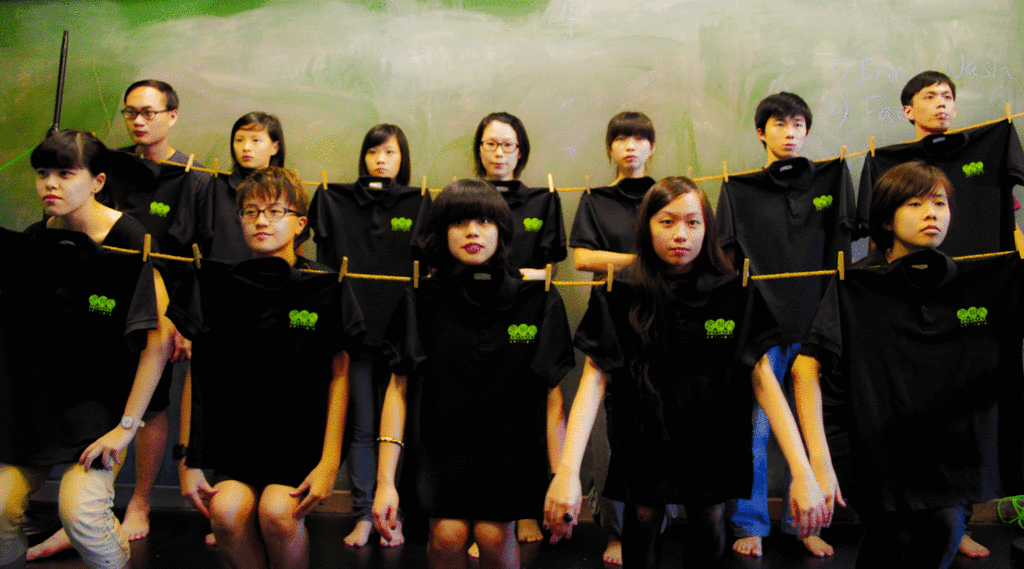
艺树人是本地剧场戏剧盒旗下的青年部,由12位充满热忱的年轻人组成的团体。我们希望能通过戏剧对各阶层的民众有更深入的了解和联系。
艺树人的创立是为了提供青年一个多方面训练的平台。通过三年的培训,艺树人希望能培育处一群拥有文化和社会意识的本地戏剧实践者。
我们使用一个名为O-A-O-R ( Orientation – Artistic – Organisation – Regeneration/ 定向 – 艺术性 – 组织 – 再生 )的模式,让青年们得到的不仅是艺术方面的训练,也学习组织群体和制作管理的技能。除此之外,他们会接触到各种类的戏剧,例如论坛剧场、新闻剧场等等。他们同时还会接受其他艺术形体的培训,如音乐和多媒体。
除了提高社会问题的认识和讨论,艺树人希望能质问及挑战人们的思维,并改变大众对低下层或边缘族群的一些刻板观念,让单方向的独白转化成双方都能参与的对话。
2012 年将会是第一届艺树人青年的最后一年。我们将会在毕业前呈现一部作品,而灵感来至于高行健的《车站》。这作品会是艺树人培训三年来的精髓,也是我们对于原作和现今社会的反思。
About ARTivate
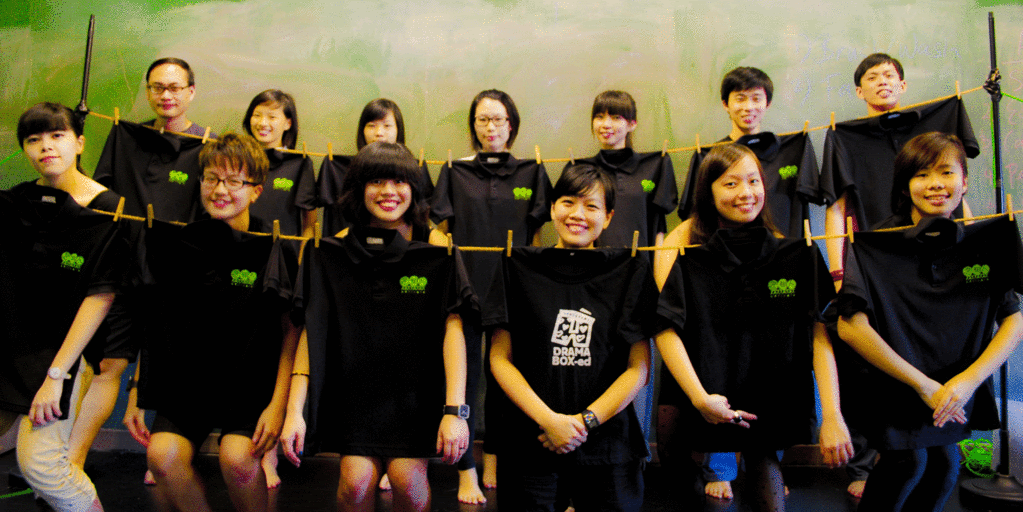
ARTivate - the youth wing of local theatre company Drama Box - is made up of a group of 12 passionate youths who aims to reach out to the community through the arts.
ARTivate was first established with the aim to provide a platform for youths who want to explore and gain all-rounded insight into theatre. Through a three-year program, ARTivate hopes to nurture a group of youths into cultured and socially aware theatre-practitioners in Singapore.
Using an O-A-O-R (Orientation-Artistic-Organization-Regeneration) model, these youths are trained not only artistically but also in organizational skills and production management. They will be exposed to different forms of theatre such as Forum Theatre and Newspaper Theatre. They will also be trained in other art forms such as music and multimedia.
Besides bringing awareness to the themes explored, ARTivators hopes to question, probe or even challenge minds. They want to engage audiences in discussion – to turn monologues into dialogues.
As 2012 will the last year of the pioneer batch of ARTivate youths, they will be putting up a piece of performance, Bus Stop, inspired by “Bus Stop” written by renowned playwright, Gao Xing Jian. This performance will be a collation of the trainings the youths had undergone for the past 3 years, as well as a critical perspective and evaluation of the script, in reference to the current society the youths are in.
许慧铃 Koh Hui Ling
艺术总监 Artistic Director
 母性泛滥; 热爱人
母性泛滥; 热爱人
着重于戏剧/剧场的应用与教学法
Overpowering maternal instincts
Loves Human(ity)
Aims at developing the use of applied drama / theatre
梁海彬 Neo Hai Bin
 长着翅膀
长着翅膀
在剧场里翱翔...
一个
鸟人。
The world's a stage...
I'm in the latecomer's queue.
刘佳宜 Liew Jiayi
 我在南大念心理学科。心理学对我来说,跟戏剧的妙处不相上下。
我在南大念心理学科。心理学对我来说,跟戏剧的妙处不相上下。
越做,越发现,我懂得不多。越不懂,就越想发现,越想继续做 (:
I am currently an undergrad in NTU. My major is psychology and the most common question asked when I reveal that fact is whether I can read his/her mind. Honestly, I cannot lah. Currently, I am daydreaming about my future hoping to achieve 2 things i enjoy alot in life: Theatre and Psychology (:
林丹凤 Lam Dan Fong
 就读南洋理工大学。
就读南洋理工大学。
习惯催眠自己就读的科目与艺术(剧场)有关。还在探索当中。
2012年5月毕业后,领悟到了答案再跟大家分享。
Studying Accountancy in NTU and living a second life in theatre, where (fortunately) the former will end in 2012 May. Believes that there is a connection between numbers and the arts, or maybe, I am just living in denial all the time.
林慧萍 Lim Hwee Peng
 法律系学生。
法律系学生。
正在面临"刻年"危机。
志愿当长发公主。
Law student.
Currently experiencing "quarter-life" crisis.
Aspiring Rapunzel.
张英豪 Teo Eng Hao
 正值后青春期的门槛状态。
正值后青春期的门槛状态。
剧场爱好者,正在学习做个剧场人。
热血梦想:征服全世界,或,不被世界驯服。
励志宣言:剧场就是Play! 让我们一起玩转地球!
A post-graduate student from NTU Division of Chinese.
韩雪梅 Han Xuemei
 热爱的东西太多,拥有的时间有限。
热爱的东西太多,拥有的时间有限。
记性日渐退化,一年比一年老。
Carries an overwhelming amount of passion for an overwhelming number of things, coping with the limited amount of time.
Struggling against a degenerating capacity to remember, and aging year by year.
Like anybody else.
王放 Kate
 在国大读书.
在国大读书.
写这个东西简直比写任何论文还难!
An undergrad at NUS.
Coming out with this line is harder than any paper I've ever written.
谢秀彬 Entia Seah Siew Ping
 南大中文系毕业。非常健忘,经常丢三落四。
南大中文系毕业。非常健忘,经常丢三落四。
热爱教育,喜欢和人接触。
Some people say that I look like an ah-lian when I’m quiet and sounds like an auntie when I speak.
I embrace all these comments and aspire to be an elegant ah-lian and intelligent auntie!
何健僮 Ho Jian Tong
 在2009年毕业于新加坡国立大学的科学系。由于我目前还在学习编剧和导戏的工作,未能有值得一提的代表作。
在2009年毕业于新加坡国立大学的科学系。由于我目前还在学习编剧和导戏的工作,未能有值得一提的代表作。
Graduated from “The Brainforest of Clementi” with an Honours degree in Life Sciences. As I am currently learning to write and direct plays properly, I do not have any work that is worthy of mention as yet.
骆丽诗 Myra Loke
 爱与剧场牵手,与社会学接吻。
爱与剧场牵手,与社会学接吻。
Sometimes we need to be crazy, to be human.
陈玮婷 Tan Wei Ting
 艺树人面试那一天,我告诉许慧铃:"其实我想要做的是电影。"
艺树人面试那一天,我告诉许慧铃:"其实我想要做的是电影。"
南大电影系上课头一天,我告诉教授:"其实我要做的是剧场。"
三年的时间找一找自己,也够了。
I started doing Theatre thinking that I want to do Film.
Now I'm studying Film determined to do Theatre.
Funny yea?
2009年11月13日
第七堂Biomechanics课
上新期,艺树人以一系列的活动来练习Meyerhold的otkaz, posil和stoica:
- 边走,边把网球随意丢给对方
- 大家集合成组,各组随意走动,但换方向时不是随着一个人的带领,而是整组人的舆论 (与“fish exercise”相反)
- 俩人之间的“老鹰捉小鸡”游戏
艺树人各个的动作必须干净利落,才能让对方有办法预料自己的下一个动作。
接着,我们以腹部的肌肉,以上的三个原则和 tochka的变化来锻炼自己的平衡。李邪把同样大小的木立方体摆成一线,让艺树人像踩石头过河一样地踩过它们,到房间地另一端。立方体之间的距离慢慢地增加、大小和方向也变了,加上李邪的其他要求,例如转动身子或在原地转圈才能踩在立方体上。这些小小的更改使每向活动比之前的更难,但大家都玩得很开心。
休息过后,我们继续学习李邪为艺树人设计的Meyerhold的etude, “The Slap”。艺树人学会了Meyerhold的握手方式,还有准备给人一巴掌的姿势。从头练习整个etude是一件蛮辛苦的事,因为Meyerhold要求的准确性和我们平常不习惯的姿势使用的肌肉很少会被动用到。要不是这些etude,我想,这些肌肉差不多能说是永远都不会派上用场。
艺树人也以竹竿训练自己的平衡。我们得一边以手掌心平衡竹竿,一边在房间里走动、结伴在房间的中央点相遇,也让竹竿在两手之间交换。平衡着这么长的一支竹竿到处乱走一点也不简单,但看着对方怕竹竿掉的那焦急的样子实在另人发笑。
课结束时,艺树人的肌肉大多数都有点酸痛。但是,参插了喜悦和欢笑,一切都是值得的。这星期,我们应该会学习怎么给对方一巴掌了吧。真期待星期六的课!
In our last lesson, ARTivate continued working on our otkaz, posil and stoica through games activities such as:
- Throwing an increasing number of tennis balls across the room while moving in a random manner
- Moving around the room in groups, with every change in direction effected by general consensus and not following a leader (as opposed to the “fish exercise”)
- The game of laoyingzhuoxiaoji (“eagle and the chicken/chick”?) between each pair
Each ARTivator had to ensure that his/her actions are executed precisely so as to facilitate anticipation in the other parties.
We then practised our balancing skills, which consists of grouping our core muscles, the three principles listed above and switching of our tochka every step we take. Wooden cubes of the same size were placed in the middle of the room and every ARTivator had to cross the room by stepping on them, similar to crossing a river while stepping on stones. The distance between each cube was slowly increased and soon, even the size of the cubes was varied, and also the orientation of the cubes. Other requirements were added, such as rotating your upper body three times before crossing the “river” and spinning 360° before getting up a cube. All these little changes increased the difficulty at each stage but they were really simple activities that could keep us entertained.
We then continued learning Meyerhold’s etude, “The Slap”, as modified by Li Xie for the amateur ARTivators. From last week’s “greeting position”, we proceeded on to “greet” and “preparation to slap”. Revising these actions right from the start was really tiring. All the weird angles and the need for clean lines definitely put my lazy muscles to a good test.
We concluded the day by honing our balance with the help of bamboo poles. By balancing these poles on our palms, each ARTivators had to move around the room, meet up with a partner halfway through and even shift the poles from one palm to another. It certainly was no easy task moving around with a long extension from the middle of your palms but nonetheless, we enjoyed that activity very much.
Once again, the lesson ended on quite a good note, with it’s fair share of laughter and muscle aches (from staying in the same position while practising the etude). I’m definitely looking forward to learning the actual slap. *evil laughter*

艺树人的过往镜头
_______________________________________________________________________
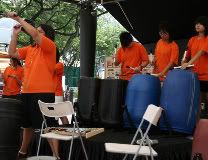
- The FLAMES利用环保乐器所带来的精彩表演
补天计划之《绿吗?》
2008年1月
《绿吗?》是戏剧盒08年以环保为主题的社区演出系列的一部分。
艺术人希望通过此活动,让公众,特别是青少年,对环境有更深的认识,并且更了解自己对环境造成的影响。
《父。女花》
编剧: 林丹凤
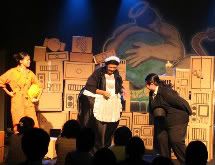
- 艺树人呈献的戏剧小品
创作灵感取自柯思仁《梦树观屋》中一句:
“砍倒一棵树,可以再种。对人类来说,这只是一件微不足道的事”。
剧中描述的是女儿面对父亲酗酒赌钱,因而要她把心爱的花卖掉的抉择。
《塑料杀死猫》
编剧: 何健僮
一个神秘女子为了名利而开始进行实验,培植一种智慧崇高的动物。因为要去远行休息,女子把实验品交给了她的管家照顾。
可是实验出现了无法想象的变化,因而对豪宅与人类的安全造成了威胁。
最终,为了把家中的大害除掉,她和管家与一手创造的动物大动干戈!

- 非一般的小型户外市集
协助编剧:郭庆亮
执导:许慧铃
返回页顶
_______________________________________________________________________
Project Mending Sky: THE GREEN MAN!
January 2008
The Green Man is part of Drama Box’s community project on Environment.
Conceptualized and organized by ARTivate, the event consists of:
- - ARTivate’s thought-provoking plays on environmental conservation
- - “The Flames” musical performance by girls from Andrew & Grace Home
- - A mini bazaar that promotes environmental conservation
Selfish, written by Lam Dan Fong, reveals a story about the decision of a daughter -
to escape into a perfect new world or remain in the world of self destruction.
Plasti-City Kills the Cat written by Ho Kian Tong, explores the harm brought about by plastics to the environment.
The plays are written under the dramaturgy of Kok Heng Leun and directed by Koh Hui Ling.
返回页顶
_______________________________________________________________________
What Matters?
July 2008

What Matters? is a package of one forum theatre play and three fringe activities which explores the issue of race with the youths of today.
Through the series of fringe activities and the Forum Theatre play, ARTivate aims to probe further into the awareness of racial issues with the youths of today and understand the true meaning of harmony between races.
Forum Theatre Play
3 students of different races set up an Adventure Club in school. As they prepare to go on a new adventure to search for fugitive Mas Selamat in their club room, an accident happened in the school and conflicts arose within the group.
*The play is performed mainly in English with some Mandarin and Malay
Fringe #1: Race in School – Stereotypes and Others
The youths were asked to move, play, think and discover, thus finding the way of dealing with racial issues in real life.
Fringe #2: Movie screening – To Kill a Mocking bird
Based on the novel by Harper Lee, this award-winning classic film present racial issues vividly on screen.
There was a discussion session after the screening facilitated by Mr. Danny Yeo.

- Sharing by young actors of Class Enemy from Bosnia
Fringe #3: Survival Ethnic Conflicts in Bosnia – a Singapore Arts Festival programme
Sharing by young actors of Class Enemy from Bosnia on their personal experiences of the war-torn times and how they have learnt to cope with growing up in an environment filled with violence caused by racial and ethnic conflicts.
Speaker: Director Haris Pasovic and the cast of CLASS ENEMY (East West Theatre Company)
返回页顶
_______________________________________________________________________
Project Mending Sky: Movie Screening
August 2008
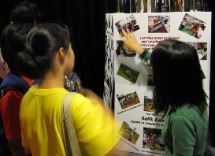
- Learning about the environment
The Movie Screening is the second installment of Project Mending Sky: The Green Man, held in conjunction with Project Mending Sky: ME (补天计划之我).
Through movie screenings and post-movie discussion sessions ARTivate hopes to explore issues surrounding our Earth’s survival amidst the damages we are inflicting on her.
Documentary-Movie #1: Winged Migration
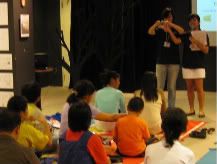
- Teaching the audience how to make dustbins using flyers
Directed by Jacques Perrin, a noted actor and film producer in France, this Academy Award nominated movie records the flight of dozens of different birds from around the globe as they follow their navigational instincts and make the taxing journey to more temperate climates in the fall.
Documentary -Movie #2: The Greening of Cuba
Cuban farmers and scientists working to reinvent a sustainable agriculture based on ecological principles and local knowledge rather than imported agricultural inputs which remind us that developed and developing nations alike can choose a healthier environment and still feed their people.

- The audience sharing
Documentary -Movie #3: The Power of Community
A follow-up to The Greening of Cuba 10 years later to see how the Cuban transitioned from a highly mechanized, industrial agricultural system to one using organic methods of farming and local, urban gardens.
Discussions facilitated by: Mr Danny Yeo and Mr Tay Lai Hock
*Language: English (with English subtitles)
返回页顶
_______________________________________________________________________
《 城S 》
2009年7月

《城S》是艺树人首个以集体创作的方式完成的作品也是艺树人经过一年演员及编剧培训后的首个演出。在集体创作引导者郭庆亮和导演许婉婧的指导下,艺树人尝试了各种即兴表演,经过不断的试验剧本才达到了令人满意的成果。
《城S》以新加坡社会和现今高度融合及环球化的世界作为语境,对城市包容性的概念进行探索。
剧中的故事呈现城市的各个面向并由一系列的行李箱奏鸣曲所串连。行李箱奏鸣曲象征了一个旅程,让大家通过这个旅程反思多数人如何建构与看待社会中的意识形态。
在剧中,转制的体制,不和谐的状况,受歧视,被限制,被异化,被压抑等诸如此类的现实情况将被正视。多数人所作的决定能代表少数人的意见吗?在这场力争上游的竞赛中,精英又是否会考虑到一般老百姓的福利呢?你的言行举动是出自你的本意又或是受到其他人的影响?
艺树人希望观众能够通过观赏此剧重新思考真正具有包容性的城市所蕴含的意义再回答自己这些问题。
由艺树人集体创作和演出, 郭庆亮担任集体创作引导者, 许婉婧(戏剧盒艺术工作伙伴)导演.
*演出主要以中文进行。(提供英文字幕)
返回页顶
_______________________________________________________________________
CityS
July 2009
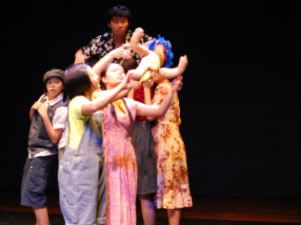 Part of a double-bill during
Part of a double-bill during
Singapore Drama Educators Association (SDEA) Celebrate Drama 2009
“CityS” is ARTivate’s first devised play. It is also ARTivate’s debut presentation following a year-round capacity-building process, during which the ARTivators underwent a series of training involving acting and playwrighting.
It is conceived and brought to satisfactory theatrical fruition by the collaboration of all ARTivators via a gradual process and accumulation of brainstorming and improvisation, under the guidance of devising facilitator Kok Heng Leun and director Koh Wan Ching.
“CityS” explores the concept of an inclusive city, in Singapore’s context, and in the context of our current highly integrated, globalised world.
In this play, stories from different aspects of a city are connected by a series of luggage sonatas which symbolizes a journey that questions the ideology constructed and perceived by majority of the society. Realities are confronted: autocracy, disharmony, discrimination, limitations, alienation, oppression and the likes. Does the decision of the majority always account for the minority? Will the elites ever consider the welfare of their downtown folks in this race to the top? Is that action you took out of free will or under the influence of others?
ARTivate hopes that audiences will reconsider the meaning of a truly inclusive city after watching the play and in turn, answer these questions for themselves.
Devised and performed by
ARTivateDevising facilitated by
Kok Heng Leun Directed by
Koh Wan Ching
*Performed mainly in Mandarin. (English Surtitles provided)
返回页顶
_______________________________________________________________________
《嘘… 审查:论坛剧场演出》
2010年9月

为了提高人们对审查制度的意识并让大家了解审查如何渗透生活,这个演出原本准备使用具象征性的舞台设计并进行现场音乐伴奏,冲破语言和种族的障碍让观众发现审查的力量。演出以5个小品组成,是艺树人经过5个月严密训练创作的结晶。
然而,距离演出仅剩三周的时候,新加坡媒体发展局告知我们户外表演执照不被批准。由于短剧探讨”敏感”课题,当局要求演出必须附上“含有成人议题”的说明并声称只有在室内演出,才能有效地执行说明。
因此,我们最后决定取消原本的演出,重新创作另一出论坛剧场来探讨在重要的课题上保持沉默,或刻意隐瞒实情所带来的诸多问题,而这些问题又如何导致沟通、对话上的断层。
导演:
郭庆亮, 与
艺树人联合创作
现场音乐:
光弧宫
返回页顶
_______________________________________________________________________
shh… censorship: a forum theatre performance
September 2010

This forum theatre performance is a wordless piece that comprises of 5 short pieces. Using a symbolic set design, and featuring live music accompaniment by ARCN TEMPL, this performance hope to transcend language and racial barriers, leading its viewers in discovering the power of censorship, with the aim of creating awareness in the communities about how censorship affects their daily lives.
However, just 3 weeks from our performance, MDA denied us of an outdoor performance license. The authorities gave an advisory for mature content due to the “sensitive nature” of the topics discussed, and claimed that we had to perform indoors in order to administer the advisory.
We stand by our position that the piece should be performed outdoors to reach as diverse a crowd as possible and believe that the issue of censorship should still be addressed. Therefore, we decided to withdraw the original piece from our programme, and replaced it with a new Forum Theatre performance, which discussed the problems of imposing silence and withholding information about important issues.
Devised and performed by ARTivate, this performance is the result of five months of training in Forum Theatre.
Comprising of five short pieces, imploring you to join us in discovering the power of censorship.
Directed by
Kok Heng Leun, co-created with
ARTivate
Live music by
ARCN TEMPL
返回页顶
_______________________________________________________________________
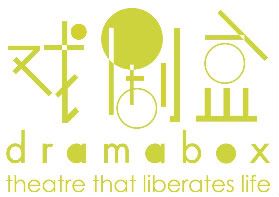
戏剧盒是新加坡最富代表性的现代华语剧团。它也是非盈利的慈善团体。成立于1990年,它凭着关怀社会的人文精神,对公民教育的积极态度,获得了广大观众的肯定。我们的演出除了富娱乐性和趣味性,也常常让观众深思并省思。
Drama Box is Singapore's most prominent contemporary Mandarin theatre company. It is a professional non-profit company with charity status. Formed in 1990, it has since gained a respectable reputation for its acute sensitivity and perception in heightening social awareness and civic responsibility. Our productions remain fun and entertaining, yet thought-provoking and reflective.
戏剧盒omy部落格告诉你戏剧盒的点点滴滴!
白色空间 之 编剧系列
继2001年演员训练工作室《白色空间》后,戏剧盒再度出发为本地中文戏剧界开拓新能量,推出为期18个月的剧本孵化室 --《白色空间之编剧系列》。通过新旧剧本创作者的定期沟通与互动,催生新一波原创剧本,捕捉属于我们时代的脉动。
Blanc Space
The Blanc Space was inaugurated in 2000 to provide a training platform for performers. In 2007, the company expanded Blanc Space to include programmes for budding directors and aspiring playwrights.




 母性泛滥; 热爱人
母性泛滥; 热爱人 长着翅膀
长着翅膀 我在南大念心理学科。心理学对我来说,跟戏剧的妙处不相上下。
我在南大念心理学科。心理学对我来说,跟戏剧的妙处不相上下。 就读南洋理工大学。
就读南洋理工大学。 法律系学生。
法律系学生。 正值后青春期的门槛状态。
正值后青春期的门槛状态。 热爱的东西太多,拥有的时间有限。
热爱的东西太多,拥有的时间有限。 在国大读书.
在国大读书. 南大中文系毕业。非常健忘,经常丢三落四。
南大中文系毕业。非常健忘,经常丢三落四。 在2009年毕业于新加坡国立大学的科学系。由于我目前还在学习编剧和导戏的工作,未能有值得一提的代表作。
在2009年毕业于新加坡国立大学的科学系。由于我目前还在学习编剧和导戏的工作,未能有值得一提的代表作。 爱与剧场牵手,与社会学接吻。
爱与剧场牵手,与社会学接吻。 艺树人面试那一天,我告诉许慧铃:"其实我想要做的是电影。"
艺树人面试那一天,我告诉许慧铃:"其实我想要做的是电影。" 











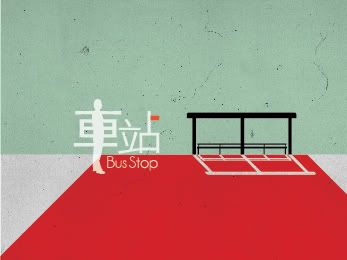

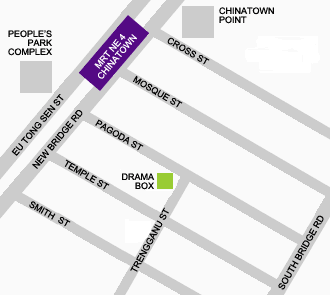

0 条评论:
发表评论
订阅 博文评论 [Atom]
<< 主页